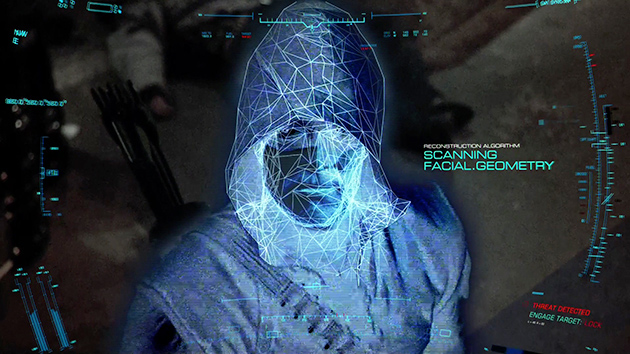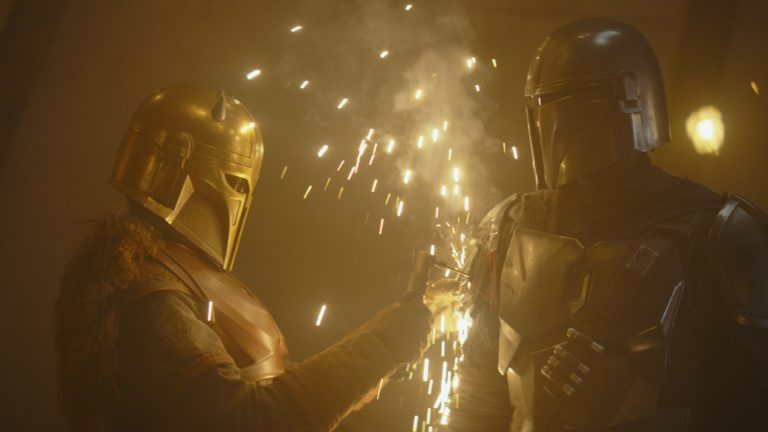Scarab Digital’s UI Artist Explains How to Create Futurist, Functional Tech Fast
Superheroes aren’t like us, so we don’t expect their gadgetry to be of our everyday world. We expect it to be techy and futuristic — yet functional in at least some reasonable way that doesn’t seem hokey. Fortunately, even with strict budget and time constraints, it is possible to get that sort of look and feel. The key, says motion graphics artist Robyn Haddow, is understanding how to make things look complex when they really aren’t.
Robyn Haddow and two other Scarab Digital artists worked together to perfect the facial recognition software UI for a sequence in season three of Arrow.
Haddow is one of three artists at Scarab Digital, a content-creation and post-production house with offices in Vancouver and Los Angeles. Scarab has been creating effects for The Flash and Arrow, two DC Comics-based TV shows, for more than three years. With about eight days to work on most episodes, Haddow and the rest of the team use Maxon Cinema 4D and Adobe After Effects to create a wide range of effects, including futuristic user interfaces (UIs) and heads-up displays (HUDs), location trackers and surveillance tech, diagnostic controls and schematics for gadgetry and health readouts for vitals and superhero suits.
Haddow used a polyFX and a random effector combined with cel render passes to make the diagnostic scanner screen on The Flash’s suit look more interesting and high tech.
I talked with Haddow, who specializes in user interface design and creation, about two recent projects she collaborated on with her Scarab teammates, Nick Oja and Jeremy Unrau. One of them was the creation of a HUD with facial recocgnition capability for a sequence in season three of Arrow.
Another was scanning technology for The Flash's diagnostic suit.
“We’re always trying to make a futuristic world for these superheroes,” she explains. “So we have to be thinking about how we can make things look cool and capable of doing complicated things.”
StudioDaily: Before we talk about the projects, tell me a little bit about how you got started doing motion graphics and why you gravitated toward UI.
I was doing game cinematics when Danny Ho, the owner of Scarab Digital, contacted me about becoming their UI artist. But it had been a lifelong goal of mine to attend film school, and it was there that I discovered motion graphics and came across the work of Mark Coleran. I remember being so intrigued and fascinated by some of the work Coleran had done for films such as The Island, Mr. and Mrs. Smith, and Lara Croft: Tomb Raider. I loved the detail, strong element of design, the idea of functionality, the technical aesthetic and combination of 2D and 3D graphics in his work. I committed to studying and learning the craft.
Haddow and her teammates used Mograph to build a particle accelerator for a sequence in The Flash.
I know deadlines are tight for these shows. Can you talk a little bit about Scarab Digital’s process for creating engaging effects quickly?
Most graphics you see in movies are shot green-screen or with placeholders so the graphics can be overlaid in post and burned in. At Scarab, we do playback for production, which means we build all of the graphics that go to set and then put them into an interactive program so they can be operated by people behind the camera when the camera is rolling. This way, the actors are actually interacting with the intended graphics live, and it’s cool because you get all of the real-world reflections and lighting elements, as well as giving the director creative freedom when blocking shots. One of the main things we do is build things in loops, which make the screens look like they always have acitivity, so there is always movement on the monitors and things look alive.
Tell me about the HUD and UI graphics you created for Arrow.
A 3D asset of Oliver Queen was comped and match moved by stitching together an image sequence of the actor, Stephen Amell.
The sequence is all about Atom, a superhero, using facial recognition software to recognize Oliver Queen, another superhero known as The Arrow. Oliver has temporarily crossed over to the dark side and doesn’t know who he is. We wanted something super techy-looking with a computer-generated feel, and the magic button for that is wireframe. For the head of Oliver Queen, Nick went on set and shot a 360-degree image sequence of the actor’s face. We used ReCap360, an Autodesk plugin, to generate a mesh of his face and brought it into Cinema 4D to play around with different looks and make the computer-generated reconstruction of Arrow’s face that Atom sees when he looks at him.
Haddow used C4D’s Hair tool to give the HUD’s OBJ a super-tech look.
I used a polygon reduction deformer tool in Cinema to get a tessellated-looking mesh, atom array and random effectors. Jeremy created the look with all of the heavy blues and glows. He gave the scene the depth it has by creating a 2.5D environment. All three of us worked together on this, and I really love when you get to work with other artists. That’s how we get a really strong finished product.
Let’s talk about your work on The Flash. The show is based on the DC Comics character Barry Allen whose superhero persona is The Flash. I know his home base is S.T.A.R. Labs and there’s a lot of high-tech gadgetry there. Tell me about the suit Scarab created for the character.
Haddow used polyFX and a random effector combined with cel render passes for the look of this scanner.
The suit allows The Flash to communicate with S.T.A.R. Labs when he’s out racing around, so they can tell him how fast he needs to run to go straight up the side of a building or whatever he’s trying to do. I worked on the suit’s diagnostic UI, which monitors The Flash’s health and the condition of the suit itself. One of the other important things the team at S.T.A.R. Labs monitors is brain activity.
Here Haddow shows two character’s brains while they’re under a telepathic spell from a metahuman in The Flash.
Haddow used orange highlights to show overactive brain activity and used the Red Giant Trapcode plugin Form for After Effects to make the effect more dynamic.
For that effect, I animated a noise texture in Cinema and brought it into After Effects, where I mapped different colors to it. In the episode, people were under the spell of The Flash’s evil nemesis, Grodd, and the bright colors were showing how that looked in their brains. I used an After Effects plugin, [Red Giant Trapcode] Form, to give the blue-and-green outer layer of the brain a scientific, holographic look so light would interact with it differently. Again, it was quick to do, but it looks more technical and complex than just a shaded brain.
Hi-tech gadgetry inside S.T.A.R. Labs running calculations for a wormhole.
As a playback artist, the main job is to assist in telling the story. We telegraph the script through screen graphics. The team at Scarab Digital works hard at creating concise pieces of playback in the deadline-driven environment of episodic TV and film. Each artist has their own strength, and it is the combination of our efforts that makes the work strong.
Meleah Maynard is a freelance writer and editor in Minneapolis, Minnesota.
Crafts: VFX/Animation
Sections: Creativity
Topics: adobe After Effects cinema 4d Maxon Red Giant robyn haddow scarab digital Trapcode Form
Did you enjoy this article? Sign up to receive the StudioDaily Fix eletter containing the latest stories, including news, videos, interviews, reviews and more.




















What is the mobile user interface used in arrow tv series by oliver queen?